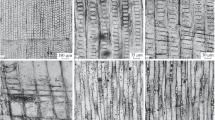Abstract
A vesselless fossil wood was discovered in the Miocene Yanagida Formation in the Noto Peninsula, central Japan. This fossil has distinct growth rings with gradual transition from the early- to the latewood ; tracheids, which are called 'usual traeheids' here, constitute the ground mass of the wood and have typical scalariform bordered pits on radial walls in the earlywood and circular sparse pits on those in the latewood ; rays are 1\2-4 cells wide and heterogeneous with low to high uniseriate wings; axial parenchyma strands are scattered in the latewood. This wood has a peculiar feature; sporadic radial files of broad tracheids whose tangential walls have crowded alternate bordered pits. The radial walls have crowded half-bordered pits to ray cells, but no pits to the usual tracheids. Among all of the extant and extinct angiosperms and gymnosperms, these unusual tracheids occur only in Tetracentron. From these features, we refer the fossil to the extant genus Tetracentron, and name it T. japonoxylum. A revision of homoxylic woods is made for comparision with the present fossil. Tetracentron japonoxylum is the only fossil wood of Tetracentron.
Similar content being viewed by others
References
Bose, M.N. 1953.Bucklandia sahni sp. nov. from the Jurassic of the Rajmahal Hills, Bihar. Palaeobotanist2: 41–50.
1954. OnSahnioxylon rajmahalense, a new name forHomoxylon rajmahalense Sahni, andS. andrewsii new species ofSahnioxylon from Amrapara in the Rajmahal Hills, Bihar. Palaeobotanist3: 1–8.
Boureau, P.E. 1954. Decouverte du genreHomoxylon Sahni, dans les terrains secondaires de la Nouvelle-Calédonie. Mem. Mus. Nat. Hist. Nat., Paris, N.S., Ser. C. Sci. Terre,3: 129–143.
. 1955. Etude paléoxylologique la Nouvelle-Calédonie (I): Sur unHomoxylon australe n. sp., bois fossile du Marais de Mara. Bull. Mus. Nat. Hist. Nat., Paris, Ser. 2,27: 341–346.
1957. Anatomie vegetale. Tome III, p. 661. Presses-Univ. France, Paris.
Cronquist, A. 1988. The evolution and classification of flowering plants. 2nd ed. 555 pp. New York Botanical Garden, New York.
Greguss, P. 1963. A new homoxylous tree in the Miocene flora of Hungary,Tetracentronites hungaricum nov. sp. Palaeobotanist12: 277–281.
Hartig, T. 1848. Beiträge zur Geschichite der Pflanzen und zur Kenntniss der norddeutschen Braunkohlen-Flora. Bot. Zeit. Jahr.6 (10 stuck): 185–190.
Hergert, H.L. andH.K. Phinney. 1954.Trochodendroxylon beckii gen. et sp. nov. from the Tertiary of Oregon. Bull. Torrey Bot. Club.81: 118–122.
Hsü, J. andM.N. Bose. 1952. Further information onHomoxylon rajmahalense Sahni. J. Ind. Bot. Soc.32: 1–12.
Jarmolenko, A.B. 1939. On the Mesozoic woods of the USSR devoid of vessels. Sovjetskaja Botanika67: 234–245. (in Russian with English summary).
Kräusel, R. 1955. I. Koniferen und andere Gymnospermen.In R. Kräusel and G. Leschik: Die Keuperflora von Neuewelt bei Basel. Schweiz. Paläont. Abh., Schw., Naturf. Ges.71: 1–27.
Lemoigne, Y. andW. Torres. 1988. Paléoxylologie de l'Antarctide:Sahnioxylon antarcticum n. sp. et interpretation de la double zonation des cernes des bois secondaires du genre de structure (parataxon)Sahnioxylon Bose et Sah, 1954. C.R. Acad. Sci. Paris, t. 306, ser.11: 939–945.
Mathiesen, F.J. 1932. Notes on some fossil plants from east Greenland. Meddel. om Grønl.85(4): 1–62.
Metcalfe, C.R. 1987. Anatomy of Dicotyledon, 2nd ed. Vol. III. Clarendon Press, Oxford.
Nishida, M. 1962. On some petrified plants from the Cretaceous of Choshi, Chiba Prefecture. Jap. J. Bot.18: 87–104.
Nishida, M. 1974. Diagnostic characters between vesselless angiospermous woods and eycadean woods. Symp. Morph. Stratigr. Palaeobot. (B. Sahni Inst. Paleobot., sp. pub. No. 2): 47–49.Ozaki, K. 1987.Tetracentron leaves from the Neogene of Japan. Trans. Proc. Palaeont. Soc. Japan N.S. no. 146 : 77–87.
Page, V.M. 1968. Angiosperm wood from the Upper Cretaceous of central California: part II. Amer. J. Bot.55: 168–172.
Sahni, B. 1920. Petrified plant remains from the Queensland Mesozoic and Tertiary Formations. Queensland Geol. Surv. Pub. No. 267 : 1–49.
. 1932.Homoxylon rajmahalense, gen. et sp. nov., a fossil angiospermous wood, devoid of vessels, from the Rajmahal hills, Behar. Mem. Geol. Surv. India. Palaeont. Indica, n.s.20(2): 1–19.
Salard, M. 1968. Contribution a la connaissance de la flore fossile de la Nouvelle Calédonie. PalaeontographicaB124: 1–44.
Scott, R.A. andE.A. Wheeler. 1982. Fossil woods from the Eocene Clarno Formation of Oregon. IAWA Bull. n.s.3: 135–154.
Suzuki, M. andL. Joshi. 1990. A preliminary report on the discovery of a vesselless dicotyledonous fossil wood from the Miocene of Noto Peninsula, central Japan. Plant Morphology (Tokyo)2: 1–5.
,T. Fujii andS. Noshiro. 1991. The anatomy of unusual tracheids inTetracentron wood. IAWA Bull. n.s.12: 21–31.
Sze, H.C. 1951. Petrified woods from northern Manchuria. Science Record (Peking)4: 443–457.
. 1954. On the structure and relationship ofPhoroxylon scalariforme Sze. Acta Paleontol. Sinica2: 347–354.
Tanai, T. 1981 The revision of the so-called ‘Cercidiphyllum’ leaves from the Palaeogene of north Japan. J. Fac. Sci. Hokkaido Univ., ser. IV,19: 451–484.
Van Tieghem, M.P. 1900. Sur les dicotylédones du groupe des Homoxylées. J. de Bot., Paris14: 259–297, 330–361.
Author information
Authors and Affiliations
Rights and permissions
About this article
Cite this article
Suzuki, M., Joshi, L. & Noshiro, S. Tetracentron Wood from the Miocene of Noto Peninsula, Central Japan, with a short revision of homoxylic fossil woods. Bot Mag Tokyo 104, 37–48 (1991). https://doi.org/10.1007/BF02493402
Received:
Accepted:
Issue Date:
DOI: https://doi.org/10.1007/BF02493402




